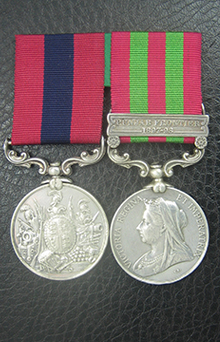
DISTINGUISHED CONDUCT MEDAL, V.R. ‘L/CORP. J. MCGEE. R. W. KENT R.’; INDIA GENERAL SERVICE 1895-1902, 1 CLASP, PUNJAB FRONTIER 1897-98 ‘2595 CORPL. J. MCGEE 1ST BN. RYL. W.... REGT.’
D.C.M. Recommendation submitted to the Queen 9 July 1898 (Army Order of 135 of 1898).
John McGee was born in Dover, Kent, and attested for the Royal West Kent Regiment at Maidstone, in September 1889. He advanced to Lance-Corporal in November 1890, and to Lance-Sergeant in May 1899. He served with the Regiment in India, December 1891 - February 1902, and particularly distinguished himself in the action at Agrah and Gat (now on the Pakistan/Afghan border) 30 September 1897, during Major-General Sir Bindon Blood’s Malakland campaign.
Regarding the action for which Corporal McGee was Awarded the DCM, ‘The Queen’s Own Royal West Kent Regiment 1881-1914’, by Lieutenant-Colonel H. D. Chaplin gives the following:
‘It was now clear that the enemy were in strength on the spurs on either side of Agrah and Ghat, and that these must be captured before the villages could be destroyed. While the cavalry continued to block the re-entrant, the brigade advanced into action. The Guides Infantry and the 1st Battalion [Royal West Kent Regiment] attacked the spur on the left of Agrah. The 31st Punjabis (from the 1st Brigade) made for the spur on the right of Ghat. The 38th Dogras were in reserve.
The 1st Battalion advanced at a quick pace with The Guides Infantry prolonging the line to the left. The tribesmen opened fire from stone sangars, on which banners were fluttering in the wind. But when the troops got within a hundred yards of them and fixed bayonets, only a dozen ghazis stood to resist the assault. The rest retired up the rocky slope, and the position was taken without a single casualty. On the right, the Punjabis captured their spur after a sharp fight. The 38th Dogras remained in rear to protect No. 7 Mountain Battery , which, firing over the heads of the troops, shelled some sangars on the higher slopes.
The brigade stayed in these positions for about an hour, during which the Sappers and Miners destroyed the two villages. When the time came to withdraw, the Punjabis could not disengage without support. To assist their retirement, the 1st Battalion was ordered to move down the slope on its right and up to the spur above the village of Ghat.
As each company arrived on the spur it came under the fire of the tribesmen, who had moved down the hill to harass the withdrawal. The troops were hampered by the terraces, and the sub-units became separated. Part of C Company, led by Lieutenant Browne-Clayton, stormed a sangar, driving the occupants up the slope. About 15 men entered the post. But after four or five of them had been hit by bullets fired from higher ground, they were ordered to withdraw. At that moment Browne-Clayton was shot dead. Before his body could be passed over the rock wall, the tribesmen suddenly charged. Major Western, who was nearby, told A Company to advance, re-take the sangar and recover the body. Captain Style was the first to reach the post; he was closely followed by Second Lieutenant Jackson and Lance-Corporal McGee.
Colour-Sergeant Willis supervised the evacuation of the dead and wounded down the slope. The 1st Battalion and the Punjabis then retired by alternate companies to the plain below, a steady fire being maintained as they fell back. Several times the tribesmen rushed within 20 yards of the rear company, but they invariably withdrew again on being charged with the bayonet.’
McGee’s service papers note his Award of the DCM for the above action on 30th Sept 1897 and has a later sub note saying; ‘recovering a rifle under very close fire’. This does not have a date but was presumably during another action during this campaign. Recovering a rifle may not now sound like something to be noted, however when fighting these tribesman, explicate orders were made not to allow rifles get into the enemies hands. These tribesman were some of the toughest opponents the British Army would fight during the period. Each was a superb marksman, using antiquated weapons and the idea of them getting hold of modern Lee Metford’s was something to be avoided at all cost!
McGee was advanced to Colour-Sergeant in April 1904, but was reduced to Sergeant the following year having been tried for drunkenness. He was discharged 10 September 1910, having served 21 years with the Colours. He re-engaged from the Army Reserve and served as Quartermaster Sergeant, Depot Royal West Kent Regiment, 15 September 1914 - 7 February 1917 (no WW1 medal entitlement). He was discharged on the latter date, and died in February 1953.
In 1897, Winston Churchill was a 23-year-old journalist attached for about six weeks to the Malakand Field Force in the Swat Valley as Britain fought rebellious Pashtun, or Pathan, tribesmen in the region -- at the time, the northwest frontier of British India. This was first time Churchill had been to ‘war’ and he sent dispatches to The Daily Telegraph about this particularly brutal campaign, writing vividly and engagingly about the land and the warlike nature of its tribes "where every man is a soldier." The letters were incorporated into Churchill's first book; ‘The Story of the Malakand Field Force: An Episode of Frontier War’ (1898). Churchill was witness to the above action and in his book he describes what happened to Lieutenant Clayton Browne. The book itself is highly recommended to anyone interested in this campaign and Churchill as it helped shape the man.
Just 22 Awards of the DCM to all regiments for the Northwest Frontier 1897-98. Of these only 2 D.C.M.’s for the action at Agrah and Gat, both to the Royal West Kent’s.
Condition; claw re-affixed on DCM, suspension slack on both medals, otherwise very fine. Ex Glendining’s, May 1986. A superb and rare Malakand award.